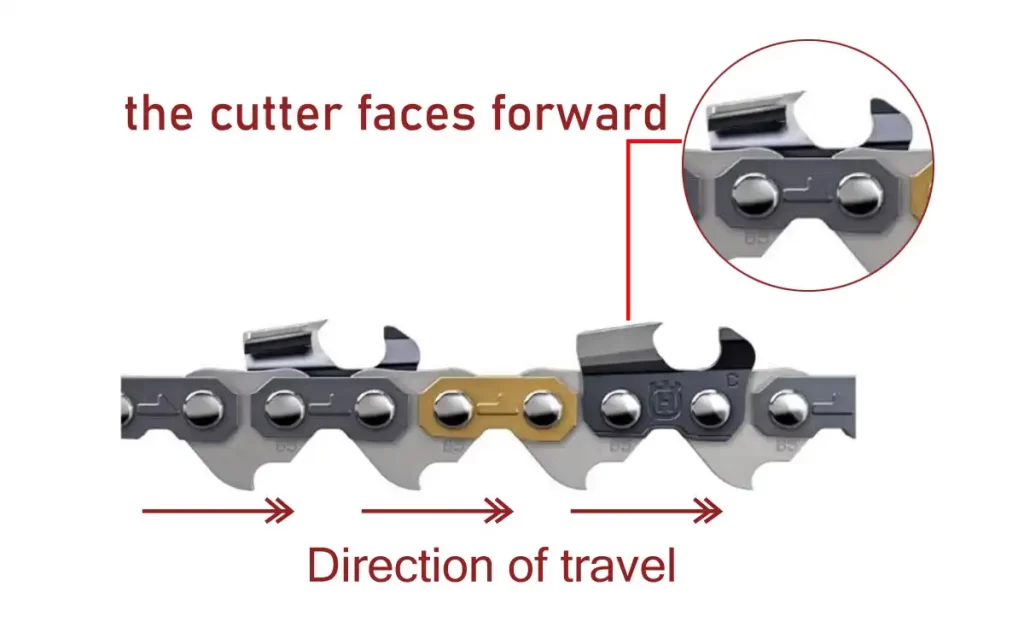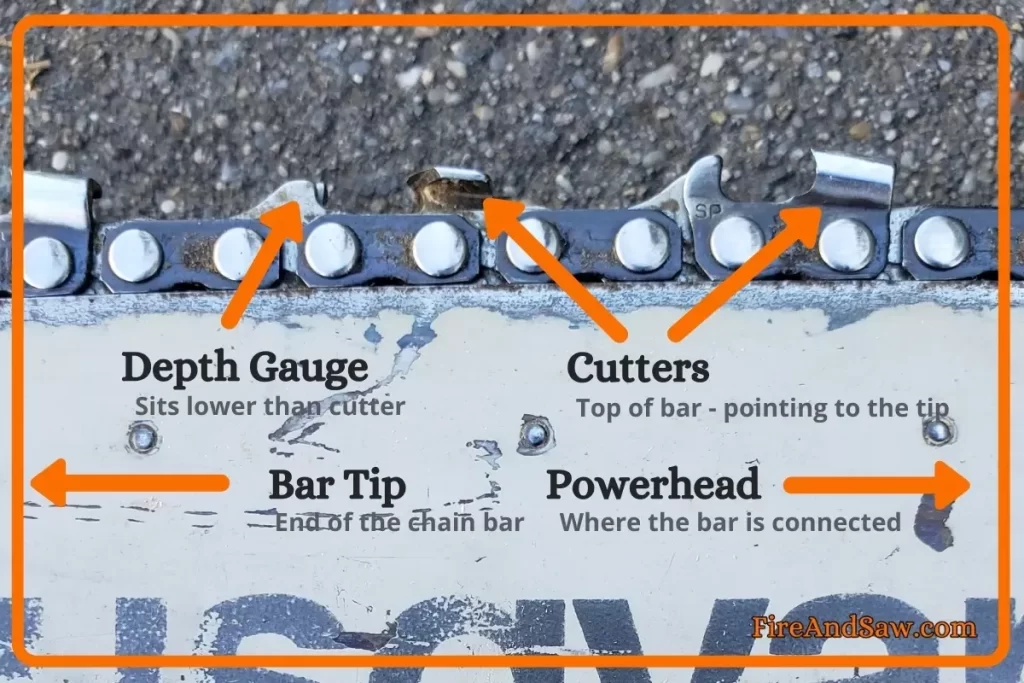The chainsaw chain direction should always move forward on the top and down at the bar’s bottom when operated. The chain’s cutting teeth should face away from the chainsaw operator.
Understanding the correct direction of your chainsaw chain is crucial for efficient and safe cutting. Chainsaws are powerful tools, and their chains are designed to rotate at a high speed to cut through wood swiftly. The blades, or teeth, must be aligned in a way that they cut when moving towards the workpiece.
The directionality ensures that the sawdust is thrown clear of the cut, reducing the risk of clogs and maintaining momentum. A chain installed backward will make the machine ineffective and increase the risk of accidents. Regular checks before use can prevent poor performance and safety hazards. Always refer to the manufacturer’s guidelines for proper chain installation and maintenance for optimal saw performance.
About Chainsaw Chain Direction
Chainsaw chain direction might not be the first thing you think of when you pick up your tool. But it’s crucial for safe and efficient cutting. A correctly oriented chain ensures that your chainsaw works effectively, reducing the risk of accidents and damage to the equipment.
Understanding the Importance of Correct Chain Direction
A chainsaw’s performance is tightly linked to how its chain moves. The right direction means smooth cuts and a long-lasting chain. A wrong direction can be dangerous. It can make the saw kick back towards the user.
- A chain facing the right direction will cut wood like butter.
- It ensures you are not forcing the machine more than needed.
- It maintains the chainsaw’s lifetime.
Basics of Chainsaw Design and Chain Orientation
Chainsaw blades have teeth that look similar but have distinct functions. Chainsaw chains are designed to cut in one direction. The teeth that face away from the chainsaw should do the cutting.
| Chain Part | Function | Correct Orientation |
|---|---|---|
| Cutters | Do the actual cutting of wood | Face away from the saw |
| Drive Links | Fit into the guide bar | Run inside the guide bar groove |
| Rakers | Decide the depth of the cut | Precede the cutters in the rotation direction |
Always check the user manual for your specific chainsaw model. Each saw might have unique characteristics. Knowing the basics ensures you set up your chainsaw chain right, every time.

Identifying the Proper Chainsaw Chain Direction
A chainsaw’s cutting power lies in the sharpness and correct installation of its chain. Correct chain direction ensures a smooth, efficient cut and maintains your safety while operating the equipment. Let’s explore how you can identify the proper chainsaw chain direction with ease.
Visual Indicators on the Chain
To determine the right way to mount your chainsaw chain, start by looking for visual indicators. These markers are designed to guide you in placing the chain correctly. Here’s what to check for:
- Cutters: The sharp, tooth-like parts should face forward on the top of the bar.
- Drive links: These flat links must fit snugly into the guide bar’s groove.
- Safety features: Safety elements should follow cutters, looking toward the bar’s nose.
These signs are visible to the naked eye and provide a simple check for proper installation.
Directional Markings and Their Meanings
Manufacturers often include directional markings on chainsaw chains to eliminate confusion. Look for these symbols:
- Arrows: Usually printed on the chain, indicating the direction it should travel around the bar.
- Text: Words like “Drive” or “Cut” might be stamped on the drive links.
Misinterpreting these signs can lead to inefficient cutting or damage to the chainsaw. Therefore, always double-check these markers before use.
Correctly aligning your chainsaw’s chain is a straightforward process with the help of visual indicators and directional markings. Remember these hints for a safer and more effective cutting experience.
Consequences of Incorrect Chain Installation
Knowing the correct way to install a chainsaw chain is crucial. A chain put on backwards won’t cut. Worse, it can cause real damage. Let’s explore the issues wrong chain direction brings.
Safety Hazards Associated With Reverse Chain Direction
Putting a chainsaw chain on backwards is risky. It can lead to kickback. Kickback is when the chainsaw moves back towards you fast. This sudden movement can cause injuries. Always check your chain’s direction to stay safe.
- Increased risk of accidents and injuries
- Chance of kickback multiplies
- Possible loss of control of the chainsaw
Impact on Chainsaw Performance and Wear
Performance drops when chainsaw chains are backwards. Cutting gets hard and takes longer. The chainsaw itself also wears out faster. You’ll need more power to try to cut with a backwards chain. This strains the motor.
| Activity | Result with Correct Installation | Result with Incorrect Installation |
|---|---|---|
| Cutting | Smooth and efficient | Difficult and ineffective |
| Wear and Tear | Normal | Increased |
| Motor Strain | Minimal | High |
Tools last longer when used right. This is true for chainsaws too. Respect your tools. Make sure to install chains correctly for best results.

Step-By-Step Guide to Installing the Chain Correctly
Knowing how to install a chainsaw chain is essential.
It ensures your safety and the chainsaw’s effectiveness.
Follow this guide to fit your chainsaw chain the right way.
Preparation and Safety Precautions
Before starting, take these steps to prepare:
- Read the manual for your specific chainsaw model.
- Wear gloves and safety glasses.
- Ensure the chainsaw is off and cool.
- Have a flat, clean space to work on.
Gather necessary tools like a tensioning tool or screwdriver.
Steps For Proper Chain Placement and Tensioning
Follow these steps to place and tension the chain:
- Release the chain brake.
- Remove side plate by loosening nuts or screws.
- Clean the guide bar and sprocket area.
- Position the chain with cutting teeth facing forward.
- Fit the chain onto the bar’s groove.
- Ensure the drive links engage with the sprocket.
- Replace the side plate. Tighten nuts partially.
- Adjust the tensioning screw for correct chain tension.
- Fully tighten the side plate nuts.
- Check the chain tension again.
The chain should move freely but not hang loose from the bar.
| Step | Task | Expected Outcome |
|---|---|---|
| 1-3 | Prep work and bar cleaning | Safe and clean workspace |
| 4-6 | Chain positioning | Chain ready for tensioning |
| 7-9 | Tensioning and securing | Secure and well-tensioned chain |
Proper installation is crucial for performance and safety.
Refer to the manual if issues arise during these steps.
Maintenance and Troubleshooting
Maintaining a chainsaw is key for optimal performance. A chain set in the wrong direction can mean trouble. It can make cuts rough or even dangerous. Regular check-ups avoid this. Chainsaws sometimes show signs of incorrect chain direction. Knowing how to fix these is crucial for chainsaw users.
Regular Maintenance to Ensure Correct Chain Direction
Regular maintenance keeps chainsaws in top shape. It helps ensure the chain moves correctly. Users should check the chain’s tension and sharpness often. Proper chain direction is easy to maintain with these steps:
- Turn off the chainsaw before inspection.
- Clean the chain of any debris or sawdust.
- Check the chain tension; adjust if loose or too tight.
- Examine the teeth and ensure they face forward on the top side.
- Use a sharpener to maintain edge performance.
- Lubricate the chain regularly for smooth operation.
Troubleshooting Common Issues With Chain Direction
Chainsaw users might face issues with chain direction. Problems can show as poor cuts or high resistance during sawing. Follow these steps to troubleshoot:
- Stop the chainsaw and wait for it to cool down.
- Disconnect the spark plug for safety.
- Check the chain orientation; the sharp edge should lead on top.
- If reversed, remove and re-install the chain correctly.
- Consult the user’s manual to confirm proper chain placement.
- Test the chainsaw on a piece of wood before actual use.
If these steps do not solve the issue, seek professional assistance or replace the chain.
Learn more: Can I Use 2 Stroke Oil for Chainsaw Bar Oil
Conclusion
Ensuring your chainsaw’s chain is correctly oriented is vital for both safety and performance. A misaligned chain can spell trouble, from inefficient cuts to potential hazards. Remember, the sharp edges should always face forward when mounted. Proper chain direction equals a smoother cutting experience.
Stay safe and maintain your tool right for optimal results. Continue your chainsaw journey with us. Visit Chainsaw Hive’s Knowledge category for articles that cut deeper into the subject.
